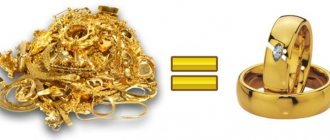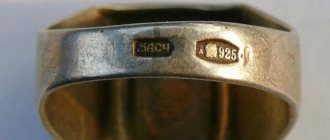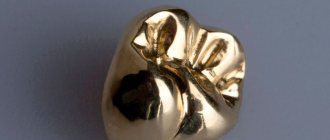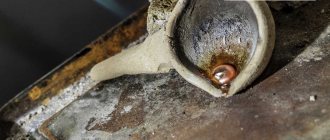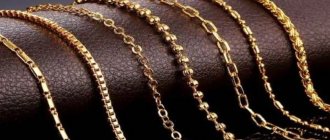From the very beginning of its mining, gold was valued by jewelers, buyers and resellers. But jewelry was created according to fashion requirements, although jewelry was passed down in families from generation to generation. And today, ancient items that no one wears are kept in boxes. Many jewelry stores offer lucrative deals and exchange old gold for new.
Features of the exchange procedure
Owners of antique jewelry can contact specialized stores and return the items. Craftsmen melt them down and turn them into new modern rings, earrings and brooches. You can pay the difference between the cost of your own and the purchased jewelry and receive the latter after the exchange.
You can donate gold to jewelers only if it was inherited or found. This is especially true for jewelry that belongs to deceased people. Astrologers do not recommend wearing them, because the metal has absorbed someone else's energy. Before contacting jewelers, you need to independently find out the cost of the product and the gold standard. In rare cases, you may come across jewelry that belonged to historical figures. Today such items are highly prized by collectors.
Sometimes there are fakes, you need to check the precious metal at home. First, bring the jewelry to a magnet; real gold is not attracted to it. Then it is dipped in vinegar or iodine. The jewelry will not darken, unlike cheap alloys. After this, you can change your decoration to a new one.
Where and how can you exchange old gold for new
Today, the most famous are two jewelry chains - Sunlight and 585 Gold. Let's look at what they can offer you.
SUNLIGHT
Some stores in this chain also have pawnshops where gold is assessed, sampled, and accepted as payment for the purchase of new jewelry. You can bring rings, earrings, chains, piercings, a cross or even a crown.
What is not eligible for exchange:
- Gold semi-finished products,
- Diamond raw materials,
- Precious nuggets, industrial products,
- Raw materials and production waste,
- Award insignia (orders and medals),
- Weapons with inlay,
- Gems.
Samples can be exchanged:
- 375,
- 500,
- 585,
- 750,
- 958,
- Dental gold (850 standard),
- Coins (900 standard).
You come to the store, hand over your items in any condition at pawnshop prices, and choose any new jewelry from the assortment of this outlet. Let us clarify once again that the reception is based on the weight of gold, without inserts and stones. Details at sunlight.net/obmen.
585GOLD
The promotion “Changing old for new, boring for fun” is valid here until the end of 2021. It allows you to bring old jewelry and receive a certificate in return in an amount equivalent to the value of the weight of the precious metal.
You can pay for the entire purchase with a certificate or part of it. The certificate can only be used on the day it is received and only at the place of purchase. When using it, you cannot additionally take advantage of promotions, discounts and coupons.
It is important that the promotion applies only to goods with a fixed price, i.e. you need to choose yellow price tags. Used goods cannot be purchased this way.
Let's summarize: if you have several pieces of jewelry lying around the house that you no longer wear, exchanging them for a new item is a good idea and a real opportunity to save money. But it is better not to sell antique or valuable items in this way; some pawnshops or collectors can give more.
If you want to find out where it’s better to invest your money to make money this year, then follow this link. If you are interested in deposits, then you can check out the best offers from banks here.
Transaction rules
Any place where gold jewelry is exchanged for new ones has its own rules and requirements for jewelry . But everyone has the same algorithm of actions. First, the master evaluates the appearance of the jewelry. It determines whether there is damage on the surface, whether the gold can be recycled, and whether it is genuine or not. The owner will have to leave the product in the store for several days.
During this time, the sample and alloy composition are checked. If the metal has passed all stages of verification, then an exchange deal is concluded. In front of the owner, the master weighs the item, calculates the cost of one gram and names the total price. During further processing, the type and appearance of the future product and its value are discussed.
But most often clients ask to exchange old gold for new gold of 585 standard. In this case, the master calculates the difference that will need to be paid. Sometimes the owner may be refused a transaction due to visible defects on the jewelry. In this case, you need to find another collection point that will accept such a product.
The cost of exchanging old silver for new and gold items depends on several criteria . The price is affected by the type of jewelry - earrings, bracelets, rings, necklaces, brooches, cufflinks or cutlery. The age, condition and appearance of the item are taken into account. In pawnshops and stores, the price is always different.
There are several risks that owners of precious metals are exposed to due to their own naivety. You should not contact jewelers who work from home. They can exchange the jewelry themselves and give the client a cheap fake. It is also not recommended to leave the product in small offices on bail, even for study and verification.
How is the price of gold determined?
As we said earlier, the salon will determine the weight of the precious metal and its purity. Each sample has its own price, for example, here are the prices in force in the Sunlight network: from 1125 to 3290 rubles.
How are prices determined? They change depending on what transactions are carried out on the London Stock Exchange, and what rate is then set by the Central Bank of Russia based on them.
The calculation is simple - the sample price multiplied by the value. For example, by 0.585 (precious metal content).
In addition, jewelry chains add additional value, which should include labor costs for making jewelry. The fact that you brought yellow or white gold may affect the final price tag; the color depends on the alloy (copper, silver, nickel or palladium is added).
Gold requirements
Typically, jewelry stores agree to accept items without special requirements. But pawnshops and private resellers put forward certain criteria. The decoration must meet the following parameters:
- sample from 350 to 850;
- the metal must undergo testing for authenticity;
- Only adults can enter into a transaction;
- when exchanging products with the same weight, a fee for the work of the master will be charged;
- Precious stones are accepted separately.
It is not necessary to have a sample on the decoration. Antique gold, inherited, may have a completely different mark. Therefore, craftsmen carry out an examination of the authenticity of gold in laboratory conditions. If the decoration has passed all stages, then the deal is officially concluded.
Only persons over 18 years of age can bring precious items to jewelry stores; sellers will definitely require a document confirming their identity. The design and style of the products are not taken into account, no matter how fine the work of the jewelers is. The owner has the right to hand over scrap - damaged gold or silver jewelry.
It is rarely possible to exchange a product for jewelry of the same weight. But when melting down old metal, you will need to pay for the work of the jeweler. If the item had inserts of precious or semi-precious stones, the master will remove them and return them to the owner. These products are changed separately at special points or stores. Stones cannot be remade; they can only be sold or exchanged for others.
Exchange places
There are several points where you can exchange old gold for new 585 standard gold. Each of them has its own advantages and disadvantages, nuances and requirements. Three main exchange places :
- jewelry stores and factories;
- private workshops;
- pawnshops.
The owner faces minimal risk if he contacts a special store or factory. At such a point you can exchange old jewelry for new ones and melt the metal into any product. In any case, the finished item will be of high quality; an appropriate test must be placed on it. But the client does not always receive the product he ordered. This is due to the need to work quickly, because the store always has a lot of orders.
Private workshops operate on the same principle. They accept gold jewelry in exchange for new ones and begin making objects based on old metal. In addition, the client can order a product of any complexity, bring his own sketches, and the master will do everything with precision. But the risk of stumbling upon scammers when choosing this option increases. Small shops often deceive their customers. Therefore, it is better to choose a trusted jeweler based on recommendations from relatives or friends. You should not take into account advertising on the Internet and newspapers; it does not provide any guarantee of the artist’s honesty.
In pawn shops you can exchange and sell jewelry. But the selection of finished products is small, since the point sells only those products that were previously pawned. And there may also be problems with the cost of jewelry. Pawnshops recalculate at their own, very low rate.
The client will have to select a cheap item or pay an impressive amount of cash for a beautiful product. The only advantage of this item is saving time. The pawnshop accepts precious metals instantly, and all the jewelry they have for exchange is always in the hands of the seller.
Option 2. Order from a private jeweler.
After what I write, all the jewelers will sue me.
If you are not the Queen of England, the President of the country or a simple oligarch, think three times before ordering jewelry from private jewelers. It would seem there are no tricks. A friend of yours recommends a jeweler who once did something for him or a friend of his, and very well. You give him the old gold, pay for the work, and in a couple of weeks he makes a completely new exclusive product from your gold. And you go around, proudly telling everyone that it was made to order by a jeweler you know. Everyone oohs and ahhs with envy, boosting your self-esteem until...
True stories retold by pawn shop appraisers and jewelry store salespeople. A man comes to hand over a piece of jewelry. The conversation goes something like this:
– I want to pawn/change/surrender this 585-carat gold chain.
– Sorry, but there is no hallmark on it, and we accept such products according to the 500th hallmark.
– But there’s a mark there, isn’t there?
– Yes, it’s unclear what manufacturer there is, but there is no sample. In addition, we must test the gold with a reagent.
- What is there to check? My friend (sometimes they even say family) jeweler made this for me to order. Okay, check it out.
– Sorry, but testing with reagents showed that the gold is not 585-grade gold / not 500-grade gold / not even 375-grade gold / not gold at all.
– ???
I'm not saying that all jewelers are liars and scammers. The absolute majority are honest and talented people. But such stories are not uncommon.
Ask the jeweler how he will set the sample . I don’t know how it is in Russia and other countries, but in Ukraine only the Assay Office can test gold items. The manufacturer has the right to put only his mark, but not the sample. There is an exception: some large manufacturers have the appropriate license and put the test on their products themselves. And one of them, by the way, is abusing this. Some products from this company do not pass the 585 test.
But this is also an exception. Everyone else takes gold products to the assay office, which checks the consistency of the sample and puts a hallmark on the product. It costs a little, but it takes time. And it is not profitable for a jeweler to spend time on one product. That's why some people are cunning: instead of the sample they use something vaguely reminiscent of it. And the client is satisfied, thinking that the sample is worth it, and the jeweler does not fall under the article.
So, only order from a jeweler you completely trust.
Pros:
- the opportunity to order something original
Minuses:
- you need a careful approach to choosing a jeweler
- high price for work
- you may not get exactly what you wanted, and in the wrong time frame
Reasons for refusal
Even during an exchange, circumstances may arise in which the masters will refuse to complete the transaction. It is better for the gold owner to familiarize himself with such nuances in advance, otherwise misunderstandings and disputes may arise. Frequent reasons for refusals:
- the presence of rough diamonds or semi-finished products in the metal;
- weapons with gold trim are not accepted;
- an offer to exchange precious-cut antiques;
- transactions for the exchange of awards and orders;
- exchange of industrial jewelry, gold wire or medical equipment, dentures.
All these types of metal are not accepted at any jewelry store. The owner can only sell such items to buyers, but at a minimum cost of gold. Exchange of old jewelry for new ones is possible only if the metal is clean, without impurities or inserts.
Do not be afraid to change precious items or melt them down. You can and even need to pamper yourself with new, more sophisticated and modern gold items. But it is better to look for proven masters and contact only them. This will avoid material and moral damage.
